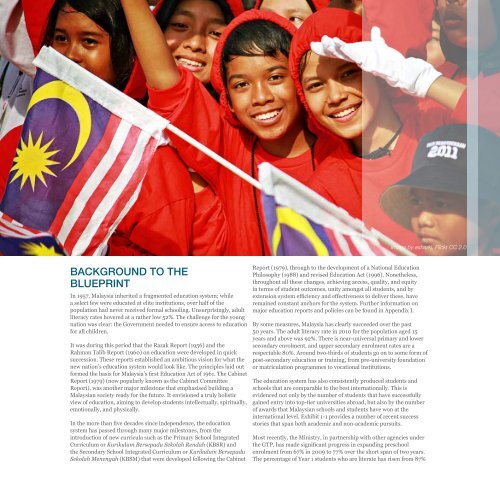Preliminary-Blueprint-Eng
Preliminary-Blueprint-Eng
Preliminary-Blueprint-Eng
Create successful ePaper yourself
Turn your PDF publications into a flip-book with our unique Google optimized e-Paper software.
Background to the<br />
<strong>Blueprint</strong><br />
In 1957, Malaysia inherited a fragmented education system; while<br />
a select few were educated at elite institutions, over half of the<br />
population had never received formal schooling. Unsurprisingly, adult<br />
literacy rates hovered at a rather low 52%. The challenge for the young<br />
nation was clear: the Government needed to ensure access to education<br />
for all children.<br />
It was during this period that the Razak Report (1956) and the<br />
Rahman Talib Report (1960) on education were developed in quick<br />
succession. These reports established an ambitious vision for what the<br />
new nation’s education system would look like. The principles laid out<br />
formed the basis for Malaysia’s first Education Act of 1961. The Cabinet<br />
Report (1979) (now popularly known as the Cabinet Committee<br />
Report), was another major milestone that emphasised building a<br />
Malaysian society ready for the future. It envisioned a truly holistic<br />
view of education, aiming to develop students intellectually, spiritually,<br />
emotionally, and physically.<br />
In the more than five decades since independence, the education<br />
system has passed through many major milestones, from the<br />
introduction of new curricula such as the Primary School Integrated<br />
Curriculum or Kurikulum Bersepadu Sekolah Rendah (KBSR) and<br />
the Secondary School Integrated Curriculum or Kurikulum Bersepadu<br />
Sekolah Menengah (KBSM) that were developed following the Cabinet<br />
Malaysia Education <strong>Blueprint</strong> 2013 - 2025<br />
Chapter 1 Context and Approach<br />
Report (1979), through to the development of a National Education<br />
Philosophy (1988) and revised Education Act (1996). Nonetheless,<br />
throughout all these changes, achieving access, quality, and equity<br />
in terms of student outcomes, unity amongst all students, and by<br />
extension system efficiency and effectiveness to deliver these, have<br />
remained constant anchors for the system. Further information on<br />
major education reports and policies can be found in Appendix I.<br />
By some measures, Malaysia has clearly succeeded over the past<br />
50 years. The adult literacy rate in 2010 for the population aged 15<br />
years and above was 92%. There is near-universal primary and lower<br />
secondary enrolment, and upper secondary enrolment rates are a<br />
respectable 80%. Around two-thirds of students go on to some form of<br />
post-secondary education or training, from pre-university foundation<br />
or matriculation programmes to vocational institutions.<br />
The education system has also consistently produced students and<br />
schools that are comparable to the best internationally. This is<br />
evidenced not only by the number of students that have successfully<br />
gained entry into top-tier universities abroad, but also by the number<br />
of awards that Malaysian schools and students have won at the<br />
international level. Exhibit 1-1 provides a number of recent success<br />
stories that span both academic and non-academic pursuits.<br />
Most recently, the Ministry, in partnership with other agencies under<br />
the GTP, has made significant progress in expanding preschool<br />
enrolment from 67% in 2009 to 77% over the short span of two years.<br />
The percentage of Year 1 students who are literate has risen from 87%<br />
Image by esharkj, Flickr CC 2.0<br />
1-2


